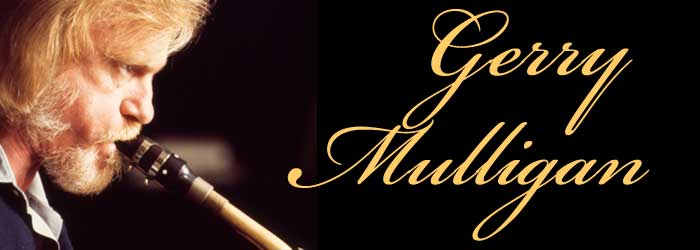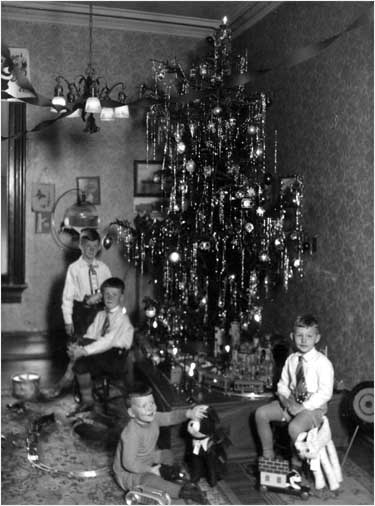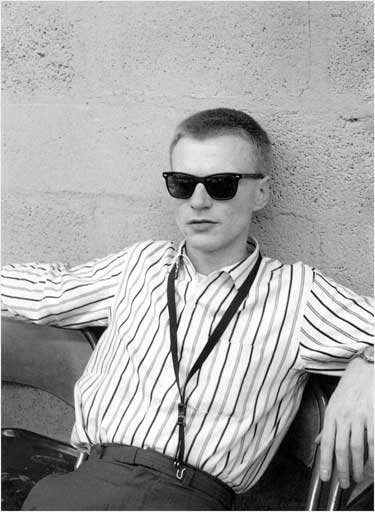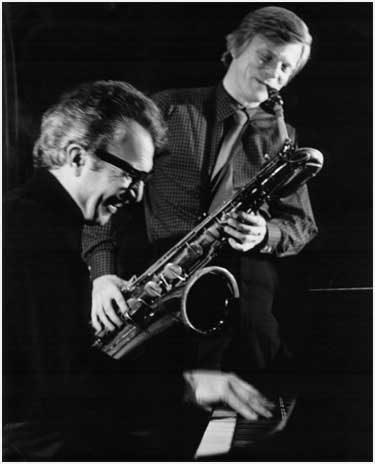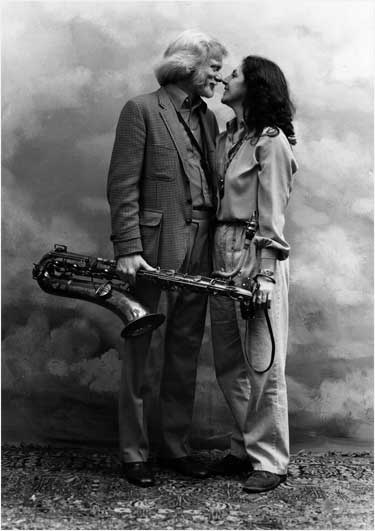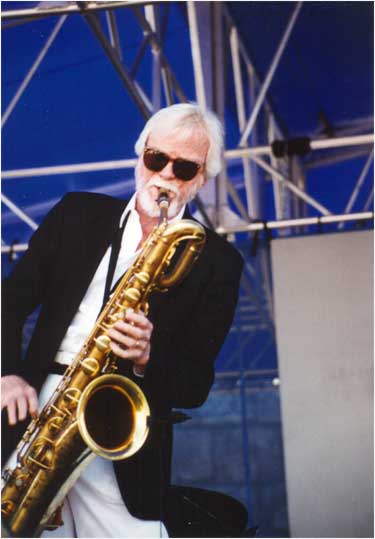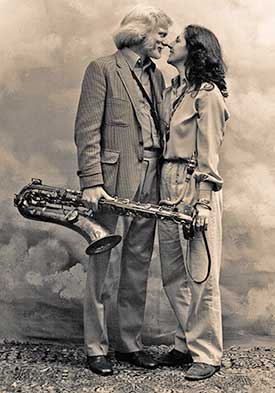One of the most widely respected and admired jazz musicians of our time, Gerry Mulligan occupies a unique place in the American musical scene. Recognized as an important 20th century composer, arranger, saxophonist, and conductor, he has played a vital role in the history of modern jazz and contemporary music. Mulligan has performed with such jazz immortals as Louis Armstrong, Count Basie, Lester Young, Duke Ellington, Miles Davis, Jack Teagarden, Dave Brubeck, and Billie Holiday. He was consistently voted number one in jazz polls around the world and has won a record twenty-nine consecutive Down Beat Readers Poll awards.
Born in New York on April 6, 1927, Mulligan spent his childhood and adolescence in several American cities as his family moved wherever his father’s career as an engineer took them. Mulligan first studied piano at the age of seven, and then began studying clarinet. He studied saxophone with Sam Correnti, who encouraged him to begin arranging. When the family moved to Philadelphia, sixteen-year-old Gerry called on Johnny Warrington, director of the WCAU-CBS radio orchestra, to offer his services.
“When you’re young and you have a vision, you have an incredible amount of guts,” Gerry explained, realizing that Warrington must have been amused by the high school kid’s display of determination. The bandleader offered constructive criticism and began buying Gerry’s arrangements. Mulligan then arranged for Tommy Tucker’s band and later returned to WCAU to arrange for Elliot Lawrence.
In the mid 1940?s, Mulligan played tenor sax in a special concert at Philadelphia’s Academy of Music that featured some of the new stars of the day: Charlie Parker, Dizzy Gillespie, and Sarah Vaughan. Gerry was pleased when a complimentary Parker invited him to a postconcert jam session. Thinking he’d been invited to the session just to listen, Gerry’s heart skipped a beat when Parker retrieved Gerry’s tenor from the checkroom, blew a few notes through it, and insisted that Gerry play. There was no refusing. “I was scared to death,” Mulligan remembered, “but Charlie was helpful and encouraging. It never hurts to have someone like him give you a shove when you’re young.”
At nineteen, Mulligan wrote and played for Gene Krupa’s orchestra and then for Claude Thornhill. Also at this time, he was studying with Gil Evans and began associating with artists such as John Lewis, Charles Mingus, Lee Konitz, George Russell, Thelonious Monk, Miles Davis, Jack “Zoot” Sims, and Al Cohn.
Immersed in the incredibly creative scene of New York in the late forties, Mulligan concentrated on his writing and arranging. His compositions and arrangements from this period were an invaluable contribution to the landmark recording Birth of the Cool. Considered one of the seminal albums of modern jazz, Birth of the Cool was elected to the Grammy Hall of Fame in 1982. The recording marked the beginning of a new direction in jazz: departing from straight bebop, Birth of the Cool emphasized improvisation in an orchestral setting. The charts were written for a nine-piece group, which included such instruments as French horn and tuba. Gerry Mulligan wrote and/or arranged six of the eleven tunes on the album. But it was Miles Davis who, as Gerry explained it “put the theories to work, called the rehearsals, hired the halls, and generally cracked the whip.” Miles Davis nicknamed Gerry “Jeru,” a name Gerry was very fond of. Although recorded in New York, this new sound became synonymous with the cool, laid-back lifestyle of the West and became known as “West Coast Jazz.”
Mulligan was delighted to be part of the extraordinary creativity in New York, but even the best jazz musicians were barely able to make a living. In 1951, he headed west in search of better opportunities, hitchhiking and playing his way across the United States.
In California in 1951, Mulligan formed the first pianoless quartet, an innovation which would influence musicians for decades to come. The quartet, which featured Chet Baker on trumpet, Carson Smith on bass, and Chico Hamilton on drums, became a focal point of the West Coast Jazz movement, even though Mulligan had always maintained headquarters on the East Coast. Later groups featured Bob Brookmeyer, Zoot Sims, Art Farmer, and Red Mitchell.
With his quartet, Mulligan often toured with Duke Ellington, whom he names as his favorite composer, and with whom he shared a passion for trains and railroads. Ellington composed “Prima Bara Dubla” for Mulligan and his good friend, baritone saxophonist Harry Carney.
Mulligan continued to lead small, medium-sized and large bands, all of which evolved from the pianoless quartet idea. “I’ll always think as an arranger,” Mulligan explained, “each band represents another writing approach.” In 1960, Mulligan formed the first Concert Jazz Band. The band appeared at the Village Vanguard in New York and featured the pianoless rhythm section, five reeds, including Gerry, and six brass. Gerry toured North America and Europe with the band and recorded five albums for Norman Granz’s Verve Records.
The album Holliday with Mulligan, recorded in New York in 1961, included four tunes by Gerry Mulligan, with lyrics by Judy Holliday, with whom he had a relationship from the late fifties to the early sixties. It features Ralph Burns, Bill Finegan, Al Cohn, and Bobby Brookmeyer. The album was not released until 1980.
From 1968 to 1972, Mulligan toured frequently with Dave Brubeck and appeared as a soloist on the Cincinnati Symphony Orchestra’s recording of Brubeck’s oratorio, The Light in the Wilderness. “In listening to Gerry Mulligan”, Brubeck once said, “you feel as if you’re listening to the past, the present, and the future of jazz, all in one tune, and yet it’s done with such taste and respect that you’re not ever aware of a change in idiom.”
Mulligan’s fascination with trains inspired his album The Age of Steam, especially the composition “K-4 Pacific.” The Age of Steam, recorded for A & M Records in 1971/1972, was an extension of Gerry’s old Concert Jazz Band and reversed the pianoless quartet rhythm section idea by using a five-piece rhythm section comprising piano, guitar, bass, drums, and percussion.
In 1974, at the recording of the Summit album with Astor Piazzolla in Milan, Italy, Gerry met his future wife, Countess Franca Rota, whose career covered managing the family wine business, working for the International Castle Institute, freelancing as a photo journalist, and reporting for Italian television in New York.
Gerry Mulligan collaborated with Judy Holliday on the musical Happy Birthday, adapted from the play written by Anita Loos, with music by Gerry Mulligan and lyrics by Judy Holliday. Happy Birthday premiered at the University of Alabama in December 1974.
In 1975, Gerry toured with his Quartet, and in the fall he performed with the New Haven Symphony Orchestra, conducted by Eric Kunzel, at Woolsey Hall in New Haven, Connecticut.
In January 1976, a Jazz Gala with Peter Herbolzheimer’s twenty-two piece orchestra toured Germany with guest stars Esther Phillips, Stan Getz, Gerry Mulligan, Nat Adderley, and Jan Toots Thieleman. Gerry then continued to tour with the Quartet until September, when he recorded Idol Gossip with a sextet, with whom he toured in Europe, joined by Art Farmer for some concerts.
In 1977, in honor of Gerry’s fiftieth birthday, the Canadian Broadcasting Company commissioned the eminent Canadian composer, Harry Freedman, to write a symphonic work. The saxophone concerto, entitled Celebration for Saxophone and Orchestra, was performed by the CBC Symphony Orchestra, with Gerry as guest soloist, and later with other symphony orchestras.
Later that year, Gerry wrote the music for the French film La Menace featuring Yves Montand, which was first released as an album in France and then in the United States.
In 1978, Mulligan reformed the Concert Jazz Band for a concert at the “Newport Jazz Festival” in New York which went on to tour in the United States.
In June of the same year, Jimmy Carter opened the festival, “Jazz at the White House,” produced by George Wein, with an impressive list of jazz greats, including Gerry.
Play with Fire, a play written by Dale Wasserman, with music by Gerry Mulligan, was performed at the Eugene O’Neill Theater in 1978.
Throughout the 1980s, the Concert Jazz Band toured the United States, Europe, and Japan. In 1981, a tour in the U.S. included a package with the Gerry Mulligan Concert Jazz Band, Woody Herman’s Orchestra, and Pete Fountain’s Band.
The album Little Big Horn found Mulligan in a different musical environment, supported by performer, composer, and arranger Dave Grusin.”There’s a fraternity among arrangers,” said Mulligan, describing his friendship with Grusin. “We all suffer similar pangs of anxiety over our work, what Quincy Jones calls the ‘rolling around under the piano syndrome’.” The six Mulligan compositions on the album include pieces for the big band, small group, and vocals. Though the pieces are written for different musical ensembles, they all share Mulligan’s distinctive melodic approach to arrangement and saxophone improvisation.
Little Big Horn was released in Italy in conjunction with the performance of the Gerry Mulligan Quartet at the Manzoni Theater in Milan. The concert, televised nationally, was estimated to have been viewed by more than six million people.
In the early 80s, Gerry coproduced The Great Songs Show for the Kool Jazz Festival with Mel Torme, which toured the United States with the Gerry Mulligan Concert Jazz Band, and George Shearing and Sarah Vaughan’s bands. Mel and Gerry also collaborated on a song entitled “The Real Thing.”
In addition to his activities in jazz, Mulligan was also building the repertory of symphonic music for baritone sax. In 1984, he commissioned his good friend, the eminent Canadian composer Harry Freedman, to write The Sax Chronicles, in which Freedman arranged some of Mulligan’s melodies in the styles of Bach, Brahms, and Mozart.
Mulligan also commissioned the Saxophone Concerto from Cincinnati composer Frank Proto. This work was premiered by the Cincinnati Symphony in 1973.
In April of 1984, Mulligan and pianist Dave Grusin appeared as soloists with the New American Orchestra in Los Angeles in the world premiere of Patrick William’s Spring Wings, written in celebration of the orchestra’s fifth anniversary.
Mulligan enjoyed a close association with Maestro Zubin Mehta, who encouraged and inspired Gerry to write for the symphony orchestra. In 1982, Gerry was invited by Maestro Mehta to play solo soprano saxophone in Ravel’s Bolero with the New York Philharmonic in the closing concert of their season.
In 1984, Mulligan completed his first composition for symphony orchestra and solo saxophone, entitled Entente for Baritone Saxophone and Orchestra. While writing Entente, Gerry also did a series of drawings which reflected the highs and lows of the composer’s mood. The work, dedicated to Maestro and Mrs. Mehta, received its world premiere in June of the same year with the Filarmonia Veneta in Italy, led by Rico Saccani. In October of 1984, Mulligan opened his European tour at the Royal Festival Hall in London, where he performed Entente and Freedman’s The Sax Chronicles with the London Symphony Orchestra, led by Michel Sasson.
In 1987, Gerry Mulligan performed Entente in Tel Aviv with the Israel Philharmonic Orchestra, led by Maestro Mehta and K-4 Pacific, his composition featuring the quartet with the orchestra. In a surprise encore, violinist Itzhak Perlman joined Mulligan and his quartet to improvise on Georgia on My Mind.
The first recording of one of Mulligan’s appearances with a symphony orchestra occurred early in 1987. Entitled Symphonic Dreams, the digitally mastered recording included music written by Mulligan and Harry Freedman, performed by the Houston Symphony Orchestra, with Erich Kunzel conducting.
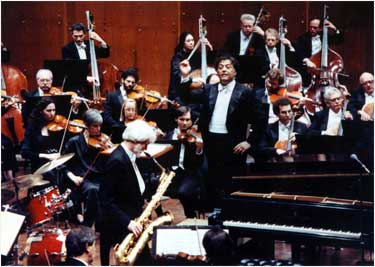
Gerry performing with the New York Philharmonic, Avery Fisher Hall, Lincoln Center, New York, December 1989. Zubin Mehta conducting. Photo by Jorjana Kellaway
Unequivocally, in December of 1989, the highlight of Mulligan’s work with symphonic orchestra occurred when the Gerry Mulligan Quartet appeared with the New York Philharmonic, led by Maestro Mehta, in a highly successful six-concert series at Lincoln Center. The program included Entente, Mr. Mulligan’s composition in which he appeared as the featured guest soloist with the orchestra, and K-4 Pacific, his composition featuring the quartet with the orchestra.
Some of Mulligan’s other engagements with symphony orchestras have included: the Stockholm Philharmonic, the American Composer’s Orchestra, and the Philadelphia Orchestra, all conducted by Dennis Russell Davies; the Los Angeles Philharmonic, conducted by Erich Kunzel; La Fenice Symphony Orchestra, conducted by Michel Sasson; the Mozarteum Orchestra of Salzburg, conducted by Martin Sieghart; the National Symphony Orchestra conducted by Fabio Mechetti; and the Australian Pops Orchestra conducted by Douglas Gamley.
In March of 1988, Mulligan was invited to Italy by the Chancellor of the University of Bologna to take part in their 900th anniversary celebrations, with a concert in the ancient city square. In June of the same year, Gerry was invited to be Composer-in-Residence at the Glasgow International Festival and was commissioned to write a work, which he entitled The Flying Scotsman.
In 1989, Mulligan recorded Lonesome Boulevard for A & M Records. The recording featured all new compositions performed by Gerry Mulligan and the Gerry Mulligan Quartet.
In 1990, Mulligan released Octet for Sea Cliff, a work for chamber orchestra. The work was commissioned by the Sea Cliff Chamber Players and received its world premiere at a concert in 1988.
The world premiere of Momo’s Clock, was presented by the Concordia Orchestra, conducted by Marin Alsop, at Alice Tully Hall, Lincoln Center, in January 1991. Gerry wrote the following comments: Momo’s Clock is my first composition for orchestra alone, without baritone saxophone and was inspired by “Momo, a book by German author Michael Ende.”
In 1991, Zarin Mehta, Executive Director of the Ravinia Festival (the summer home of the Chicago Symphony), invited Mulligan to be the artistic director for the launching of the new series of jazz concerts produced as part of Ravinia’s summer festival, Jazz in June. Mulligan served as the artistic director in 1991 and 1992, and brought the top names in jazz to the Chicago-area festival: Ella Fitzgerald, Oscar Peterson, Wynton Marsalis, and many many others.
In 1992, Mr. Mulligan revisited the “cool school” that began with the Birth of the Cool recording and assembled the Gerry Mulligan Tentet. The project, entitled “Re-Birth of the Cool” began with a recording for the GRP label with Mulligan, and Wallace Roney in Miles Davis’s trumpet chair.
In the summer of 1991, in Rotterdam, Gerry told Miles he was planning to play the music again. Miles was very enthusiastic and said to let him know when it was going to be. Sadly, it was not to be, as Miles passed away.
The Gerry Mulligan Tentet, the Re-Birth of the Cool touring band, featuring Art Farmer on flugelhorn/trumpet and Lee Konitz on alto sax, embarked on a highly successful concert tour, premiering at the Ravinia Festival in Chicago. They played to a standing-room-only audience in Los Angeles and then made their final U.S. appearance at Carnegie Hall in New York as part of the JVC Jazz Festival. After their U.S. performances, “Re-Birth of the Cool” headlined the European jazz festivals and concluded the tour with a performance in Istanbul, Turkey.
Later that same year, Mulligan appeared with other world-class saxophonists in the ceremonies celebrating the inauguration of Pres. Bill Clinton in 1992.
1993 began with a tour of Japan by the Gerry Mulligan Quartet. In September, Mr. Mulligan reassembled the Gerry Mulligan Tentet, “Re-Birth of the Cool,” for appearances in Brazil. Also in 1993, as in every year, Mulligan made several tours of Europe and appearances at Carnegie Hall.
Paraiso, an album released in 1993, was a collaboration with Brazilian vocalist Jane Duboc. The album featured six new Mulligan tunes with lyrics by Duboc and “Theme for Jobim,” used in The Player, a Robert Altman film.
In 1994, Mulligan continued his regular schedule of several European tours and numerous appearances within the United States and throughout the world.
On television, he has been the guest of Dick Cavett, Johnny Carson, Mike Douglas, Dinah Shore, Bill Boggs, and Irv Kupcinet. In 1982, a CBS-TV profile, capturing Mulligan both on tour with the Concert Jazz Band and at his Connecticut home, was broadcast on CBS Sunday Morning with Charles Kuralt. Other television appearances include a cable special with the Quartet for Jazz America, an appearance for the same producers with Dizzy Gillespie’s “Dream Band,” a program with Mel Torme for CBS, and a guest appearance on a Buddy Rich show.
Mulligan also appeared as a guest on the Barry Manilow special Big Fun on Swing Street, for CBS. Gerry was also part of the internationally televised events of the Bicentennial closing ceremonies of Liberty Weekend in New York, as a guest soloist with the Manhattan Transfer group.
At the invitation of the King and Queen of Sweden, Gerry was part of the Bob Hope TV Benefit for the Children International Summer Villages in Stockholm.
Mulligan has acted and performed on screen in such important films as I Want to Live, The Bells are Ringing, The Rat Race, and The Subterraneans. He has been featured on musical soundtracks by such outstanding film composers as André Previn, Quincy Jones, Elmer Bernstein, and Johnny Mandel.
Mulligan wrote the score for the Jack Lemmon, Peter Falk, Elaine May film version of the Broadway comedy Luv, the French adventure film La Menace, starring Yves Montand, and wrote the title tunes for A Thousand Clowns, and I’m Not Rappaport.
Mulligan is the recipient of numerous honors and awards. In 1982 the State of Connecticut, where he lived for three decades, presented him with the Connecticut Arts Award.
Mulligan won a Grammy Award in 1981 in the category of “Best Jazz Instrumental Performance by a Big Band” for his DRG album Walk on the Water. He has received other Grammy nominations for his album The Age of Steam, his composition For an Unfinished Woman, and for “Best Instrumental performance: Group” for the album Soft Lights and Sweet Music. And, of course, Birth of the Cool is in the Grammy Hall of Fame.
In November of 1984, Mulligan was awarded the prestigious Viotti Prize at a special presentation ceremony in Vercelli, Italy. Previous recipients have included Igor Stravinsky, Artur Rubenstein, A. Benedetto Michelangeli, and Carla Fracci. This was the first time that the prize was awarded to a musician from the world of jazz.
In October of 1988, Mulligan was saluted at Yale University by being named a Duke Ellington Fellow and was awarded the Duke Ellington medal.
In May of 1989, the town of Trieste, Italy, honored Mulligan and presented him with the keys to the city.
In 1990, Gerry returned to Philadelphia, the city where he spent his teenage years and sold his first arrangements, to be inducted into the Philadelphia Music Foundation’s Hall of Fame. Other inductees included violinist Efrem Zimbalist, Sr., songwriter Linda Creed, and singer Patti LaBelle.
In 1991, Mulligan was again recognized by his peers and was inducted into “The American Jazz Hall of Fame.” He was also inducted into the Lionel Hampton School of Music’s Jazz Hall of Fame in February of 1992 and was awarded the Sarasota Jazz Club’s Satchmo Award in 1993.
Mulligan was the honored guest composer at the 1992-1993 Mertens Contemporary American Composer’s Festival at the University of Bridgeport, Connecticut. The festival honors distinguished American composers, and previous winners have included Aaron Copland, Stephen Sondheim, and Leonard Bernstein. Mulligan was the second jazz composer ever to be honored by the festival since it began over twenty years ago. Dave Brubeck was commended in 1979-1980.
In January of 1994, Mulligan was elected into the Down Beat Hall of Fame. Later in 1994, Mulligan focused his attention on activities designed to further jazz education. In March, he began teaching a credit course in jazz history at the University of Bridgeport.
In 1995, the video tape The Gerry Mulligan Workshop – A Master Class on Jazz and Its Legendary Players, was produced by the Hal Leonard Corporation and released in 1997 in conjunction with The Gerry Mulligan Play-Along Collection, a publication of Mulligan’s selected compositions. Both the video and published music are designed for educational/home use.
In February 1995, Mulligan spent one week as Artist-in-Residence at the University of North Texas in Denton, Texas. The University has one of the finest Jazz Studies departments in the United States. Mulligan gave seminars, small group forums, rehearsals, and a performance with the university’s Big Band, at the Morton E. Myerson Theater in Dallas. The students had a wonderful time, and so did Gerry.
In April/May 1995, Mulligan toured in Europe with his Quartet. A number of the performances were a double bill with the Dave Brubeck Quartet. In a personal remembrance, Brubeck said: “It is difficult for me to realize that it was only a year ago at this time that we toured in Europe together. Our group would open the show, and after our bows, Gerry and I would return to the stage alone. Each night as we swung into These Foolish Things the mood would be different sometimes lyrical and sad, sometimes hard and swinging, sometimes with gentle humor but never, never a repeated formula. That was the genius of Gerry Mulligan.” They brought the house down with standing ovations.
In September, Mulligan gave a jazz master class at Northern Arizona University in Flagstaff and performed with his Quartet at the festival in Sedona, “Jazz on the Rocks.”
The Gerry Mulligan Quartet recording Dragonfly, was released in October 1995 on the Telarc label, with special guests Dave Grusin, Grover Washington, Jr., John Scofield, Dave Samuels, and Warren Vache.
In October 1995, Mulligan performed at the benefit concert: Concerto Per Essere Liberi, with the Tibetan Monks of the Sera Je Monastery in India, and Ornella Vanoni, at the Teatro Nazionale in Milan, Italy. At this extraordinary concert, he improvised with thirteen monks who played on their traditional instruments.
Gerry’s last concerts were on board the SS Norway’s Caribbean cruise with his Quartet, on November 4 and 9, 1995.
Commenting on Gerry’s performance, Gene Lees said, “I’m not sure that this should any longer be called jazz. It seems to be some kind of end-of-the-century improvised classical music.”
Gerry Mulligan was included on the Artists Committee for the 1995 Kennedy Center Honors for the Performing Arts, and in December he attended the ceremonies in Washington with his wife, Franca, including a reception at the White House, where they met Pres. and Mrs. Bill Clinton.
Mulligan was again the winner of the Downbeat International Critics and Readers Poll: Baritone Saxophonist of the Year, 1995.
Gerry had always wanted to record his collection of songs with lyrics that he wrote during his lifetime, with Phil Ramone. This was made possible by the Library of Congress via a grant from the Ira and Leonore Gershwin Fund. In the last week in December 1995, in Stamford, Connecticut, the project commenced with a number of demo singers and a film crew.
Gerry’s autobiography, recorded on tape in 1995, will eventually be published in audio and book form.
Gerry Mulligan passed away in January 1996. A Memorial Service “A Celebration of the Life of Gerry Mulligan” was held on February 12th, at St. Peter’s Church in New York.
Throughout 1996, tributes to Gerry Mulligan were performed, including concerts at Long Beach, California, with Bob Brookmeyer, Johnny Mandel, and Bill Holman, and at the Konzerthaus in Vienna, Austria, with Art Farmer, Lee Konitz, and Bob Brookmeyer.
Wynton Marsalis and the Lincoln Center Jazz Orchestra performed a concert “Jeru: The Music of Gerry Mulligan,” on October 19, 1996, at the Lincoln Center, with guest soloists Art Farmer on flumpet, and Joe Temperley on baritone saxophone. The program included music spanning Gerry’s entire career, especially the Concert Jazz Band arrangements and music from the Age of Steam album. President Clinton wrote a special greeting that was read to the audience by Wynton Marsalis before the performance. Gerry’s wish was to have Wynton and the New Orleans band at his funeral. As a personal gift to Gerry, Wynton surprised the audience by bringing the band from New Orleans on stage at the Lincoln Center, to perform the funeral march with him at the end of the concert.
The biographical film Listen: Gerry Mulligan was premiered as a pilot at the Walter Reade Theater, Lincoln Center on October 24, 1996 and presented by Wynton Marsalis. The film was sponsored by the Library of Congress via a grant from the Ira and Leonore Gershwin Fund and was produced by Gerry Mulligan Productions.
Gerry Mulligan Legacy, also sponsored by the Library of Congress via a grant from the Ira and Leonore Gershwin Fund, was released by N2K, Inc. in January 1997. This was the first jazz CD Plus (with photos and video clips after each tune) produced in the world.
1997 also saw the release of, among other recordings, Gerry Mulligan Quartet Zurich 1962, as part of the Swiss Radio Days Jazz Series, released by TCB Music, SA, and Gerry Mulligan: The Quartets, from the late fifties and early sixties, featuring Bob Brookmeyer and Art Farmer, released by Hindsight Records, Inc.
His music was also featured in the films L.A. Confidential and The Ice Storm, and in the play Deathtrap, which ran at an Off-Broadway theater in New York.
The Gerry Mulligan All-Star Tribute Band with soloists Bob Brookmeyer, Lee Konitz, and Randy Brecker, gave a concert series at the Blue Note in New York in April 1997.
In September 1998, Gerry’s saxophone was displayed on Jazz at the White House a live TV broadcast, co-hosted by Hillary Clinton and Wynton Marsalis.
The Gerry Mulligan All-Star Tribute Band returned to the Blue Note in 1998 for another concert series, and later recorded Thank You Gerry-Our Tribute to Gerry Mulligan.
In 1999, Gerry Mulligan and the Concert Jazz Big Band featuring Zoot Sims in 1960 Zurich from the Swiss Radio Series was released on CD by TCB Music, SA, Switzerland.
LIBRARY OF CONGRESS, Washington, DC
In 1992, Jon Newsom, Chief of the Music Division, Library of Congress met with Gerry and Franca Mulligan at their home in Connecticut, to discuss the deposit of all Gerry’s music manuscripts at the Library of Congress. A close friendship developed between them.
Gerry had told Franca that, “as my baritone and other instruments are so much a part of me, I would like them to be placed in a museum/institute, where they could also be played.” When Gerry passed away in 1996, Franca Mulligan felt that the Library of Congress would be the ideal place. She expressed to Jon Newsom her wish to donate Gerry’s baritone saxophone to the Library and to have a permanent exhibit space.
On April 6, 1999, the Library of Congress celebrated the opening of the permanent exhibit of the Gerry Mulligan Collection, housed in a special room at the entrance to the Performing Arts Reading Room in the Music Division, in the James Madison Memorial Building.
In the Madison Hall, where the opening ceremony took place, the Color Guard in full regalia with rifles and five flags presented arms, and the guests stood for the National Anthem, followed by a performance of the U.S. Marine Band. Gerry received a statesman’s honor, and it was the first time the U.S. Marine Band and the Color Guard had come to the Library of Congress.
In his opening remarks, James Billington said: “Gerry Mulligan, whose career spanned five decades, worked gracefully in many styles and with many artists, defying the categories that so often narrow our vision of a creative spirit. Gerry Mulligan would not, could not, be categorized, and he flourished through changing times, in many cultures, and with many musical voices ranging from the baritone saxophone that was his principal instrument, to the full orchestra.”
Billington also paid tribute to Franca Mulligan, Gerry’s wife, as “a valued friend with whom we have worked and will continue to work on many projects that have been inspired by Gerry’s life and work.”
Longtime friend of Gerry and Franca Mulligan, the Venerable Thamthog Rinpoche, abbot of monasteries in Tibet and master of the Sera Je Monastery in India and the Center of Tibetan Studies in Milan, came from Italy just for the ceremony and draped a ceremonial scarf or “Kata” on the saxophone. He made the following statement on the music of Gerry Mulligan: “Music is important to our lives, and can have a positive or negative effect, depending on our motivation, and the action of our mind. Gerry wrote beautiful music, very pure, which is a lasting and precious gift to the people of the world.”
Scott Robinson gave a special solo performance on Gerry’s baritone saxophone of the Mulligan composition Ontet, and the mellow tones of the saxophone resounded through the Madison Hall.
Franca R. Mulligan thanked everyone for coming to help mark the event, and concluded the ceremony, with the words “Happy Birthday, Gerry!”
Following the reception by the Library of Congress, and a dinner hosted by Franca Mulligan for her guests, many from Italy and other parts of the United States, the Gerry Mulligan Tribute Band performed an evening concert in the Library’s Coolidge Auditorium, in the Thomas Jefferson Building, with the Gerry Mulligan Trio and soloists Bob Brookmeyer, Randy Brecker, Dick Oatts, and Scott Robinson, who played Gerry’s baritone saxophone. He said after the concert what an inspiring experience it had been to play Gerry’s sax.

The Gerry Mulligan Collection at the Library of Congress. Photo by Caspri De Geus 1992
The permanent exhibit of the Gerry Mulligan Collection is open to the public. On display is Mulligan’s gold-plated Conn saxophone, which will be played periodically in concerts at the Library of Congress. Other items on display are photographs that document Mulligan’s long career, including one of him at age fifteen or sixteen playing his first instrument (the clarinet), music manuscripts in Mulligan’s own hand, record covers, performance programs and posters, and a 1981 Grammy that he won for the best jazz instrumental performance on his album Walk on the Water. Dominating the back wall of the exhibition are handsome woodblock-print portraits of Gerry Mulligan in different shades, by Antonio Frasconi.
Information on the permanent exhibit of The Gerry Mulligan Collection can be found at the Library of Congress website.
The Downbeat Jazz Hall of Fame Museum and Jazz Club, designed and constructed in collaboration with Universal Studios, was opened in February 1999 at Universal CityWalk in Orlando, Florida. The exhibit of great artists features a Gerry Mulligan display of memorabilia, with a handwritten manuscript and a large mural of the artists.
A doctoral dissertation by Jon Gudmundson, Assistant Professor, Saxophone, and Director of Jazz Studies at Brevard College, was presented in 1999 for the degree of Doctor of Arts, entitled “The Gerry Mulligan Quartet of 1952-53: A Study of the Arranging Style Through Selected Transcriptions.”
“Miles: A Miles Davis Retrospective” opened at the Missouri Historical Society, St. Louis, Missouri, in May 2001, and featured one of Gerry’s baritone saxophones as part of the exhibition.
The Gerry and Franca Mulligan Foundation was established in 2001, to fulfill Gerry’s wish to support talented young musicians.
Franca R. Mulligan, President of Mulligan Publishing Co., Inc., with the assistance of Cathie Phillips, who has been with the Mulligans for more than twenty years, will continue to manage the legacy of Gerry Mulligan’s music.
